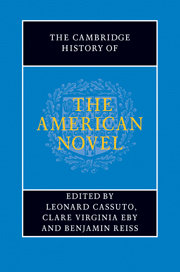Book contents
- Frontmatter
- General Introduction
- PART ONE INVENTING THE AMERICAN NOVEL
- Introduction: inventing the American novel
- 1 Transatlantic currents and the invention of the American novel
- 2 Susanna Rowson, Hannah Webster Foster, and the seduction novel in the early US
- 3 Charles Brockden Brown and the novels of the early republic
- 4 The novel in the antebellum book market
- 5 American land, American landscape, American novels
- 6 Cooper and the idea of the Indian
- 7 The nineteenth-century historical novel
- 8 Hawthorne and the aesthetics of American romance
- 9 Melville and the novel of the sea
- 10 Religion and the nineteenth-century American novel
- 11 Manhood and the early American novel
- 12 Sentimentalism
- 13 Supernatural novels
- 14 Imagining the South
- 15 Stowe, race, and the antebellum American novel
- 16 The early African American novel
- PART TWO REALISM, PROTEST, ACCOMMODATION
- PART THREE MODERNISM AND BEYOND
- PART FOUR CONTEMPORARY FORMATIONS
- A selected bibliography
- Index
2 - Susanna Rowson, Hannah Webster Foster, and the seduction novel in the early US
from PART ONE - INVENTING THE AMERICAN NOVEL
Published online by Cambridge University Press: 28 July 2011
- Frontmatter
- General Introduction
- PART ONE INVENTING THE AMERICAN NOVEL
- Introduction: inventing the American novel
- 1 Transatlantic currents and the invention of the American novel
- 2 Susanna Rowson, Hannah Webster Foster, and the seduction novel in the early US
- 3 Charles Brockden Brown and the novels of the early republic
- 4 The novel in the antebellum book market
- 5 American land, American landscape, American novels
- 6 Cooper and the idea of the Indian
- 7 The nineteenth-century historical novel
- 8 Hawthorne and the aesthetics of American romance
- 9 Melville and the novel of the sea
- 10 Religion and the nineteenth-century American novel
- 11 Manhood and the early American novel
- 12 Sentimentalism
- 13 Supernatural novels
- 14 Imagining the South
- 15 Stowe, race, and the antebellum American novel
- 16 The early African American novel
- PART TWO REALISM, PROTEST, ACCOMMODATION
- PART THREE MODERNISM AND BEYOND
- PART FOUR CONTEMPORARY FORMATIONS
- A selected bibliography
- Index
Summary
For much of its history, the seduction novel was absent from the origin tale literary historians have spun about American literature. While Susanna Rowson's Charlotte Temple (1794) and Hannah Webster Foster's The Coquette (1797) included both the love and the death that critics like Leslie Fiedler insisted were the building blocks of the American literary tradition, these novels had the details all wrong. Following a European template, these texts told a story of dependence, deceit, and downfall – hardly the stuff of national origin myths. But as Cathy Davidson and others have demonstrated, these were precisely the stories that resonated among early Americans. Seduction was everywhere in early America – not only in novels, but in magazines, newspaper accounts, and in the privileged realms of privately circulating letters and manuscripts. According to Mildred Doyle, seduction outstripped all other topics in the periodical literature of the period. The two novels I shall discuss in this chapter certainly tapped into the era' general fascination with the subject. Matthew Carey, Charlotte Temple's American publisher, estimated that the book had sold well over 50,000 copies by 1812. Foster's The Coquette went through at least ten editions between 1797 and 1866.
Once these novels were rediscovered in the twentieth century as part of a widespread recovery effort by feminist scholars, two major critical narratives emerged about them. The first focused on the seduced woman as a symbol for a young and vulnerable nation. As Jan Lewis writes, the seduction novel heroine's “attempt to navigate between the eighteenth-century Scylla of overweening power and its Charybdis of seductive liberty was the nation's plot as well.”
- Type
- Chapter
- Information
- The Cambridge History of the American Novel , pp. 37 - 50Publisher: Cambridge University PressPrint publication year: 2011
- 1
- Cited by



